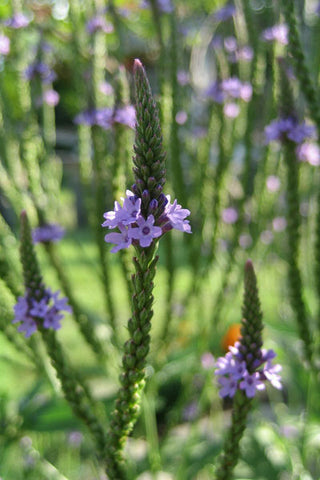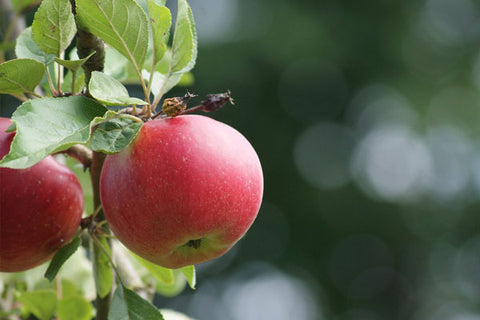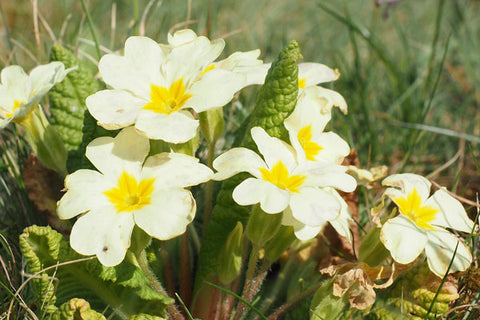
In the hidden land of Faery, travelers say, there are marvelous herbs and flowers completely unknown in the human world. Brilliant colors, intoxicating scents, and magickal plants that bring joy, visions, or sleep. And yet, over the years, fairies seem to have taken a liking to some of the more common plants right here on Earth.
This list of twelve fairy favorites is drawn mainly from folklore and literature about fairies (as well as a touch of personal experience). Since fairies live close to nature, many plants and herbs are associated with the Fae—but these ones are particularly liked by the Fair Folk. Some are traditional Faery offerings, planted or bestowed in order to win their favor. Some are considered portal herbs that can aid you in making connections with the Fae. Others are used in spells and formulas for magick of the Faery kind—especially love magick, glamours, and psychic insight.
Let your intuition guide you on how to best use these Faery herbs (observing all safety precautions, of course). To cultivate an appreciation for these storied plants is—in no small way—to step into the Faery lands. I’ve eschewed some of the more exotic plants in favor of ones that can be found without exceptional effort or expense.
Language notes: “Plant” and “herb” are used interchangeably here. Plant names are capitalized out of respect. I usually write “Faery” for the race/kingdom generally and “fairy” for individuals, but not always. (Don’t dwell on it…faeries can't stand a stickler.)
1. Bluebell

Native to England and France, Bluebells grow in lightly shaded gardens and woodlands. The bell-shaped flowers are an otherworldly blue—the rarest color in nature. The Bluebell was once named after Endymion, the sleeping lover of the moon goddess Selene. The bulbs are poisonous and can pose a danger to humans or animals who mistake them for Spring onions.
Storybook images abound of fairies playing among Bluebells. They are said to dance to the sound of the chiming flower cups. To hear a Bluebell ring is to know that fairies are near. In other (gloomier) customs, the sound presages death.
In Irish tales, it is bad luck to walk through a patch of Bluebells. To do so is to disturb the revels of the Fae and invite their displeasure. Like many fairy flowers, Bluebell is an unlucky blossom to pick or to bring indoors. To cultivate the flower, however, offers no such risks. Bluebells are a charming addition to fairy gardens. (Along with Daisies, Forget-Me-Nots, and other favorites of fairy illustrators.)
2. Vervain

Vervain is one of the most important herbs in the occult traditions of Europe. Its connection to Faery comes through Italian traditional witchcraft. Vervain is sacred to Diana, a patroness of Witches who is also called Queen of the Fairies. In Hereditary Witchcraft, Raven Grimassi writes of a fairy who dwells within the Vervain stalk, and who brings good fortune to the one who invokes her.
Druid tradition also reveres Vervain as an herb of initiation and second sight. Seers burn Vervain incense to open a window to the Otherworlds. You don't have to look very far to find Vervain in magickal literature dating back centuries. (There are several European and American species, each with slightly different energies and uses.)
3. Elderberries

Faeries love all berries! But Elderberries, with their petite size and magickal pedigree, are a fairy favorite. Elder is a Goddess tree long believed to be a gateway to the Underworld. To chop the tree or burn the wood is forbidden. Instead, Elder's gift is her abundant clusters of berries, which are picked and saved for cordials, baked goods, and medicine.
Elderberry wine and Elderberry liqueurs are a fairy delicacy. To pour a dram or two is to be sure that you always have fairy guests.
4. Foxglove

Foxglove boasts hyper-real purple flowers on long, showy stalks. Just look at some of the folkloric names of this flower: Fairy Gloves, Fairy Petticoats, Fairyweed, Fairy Bells… and so on. The common name Foxglove is probably derived from “Folks' Glove,” a British traditional word that refers to—you guessed it—the Wee Folk. The spots on the “floor” of each flower cup are said to be tracks where fairy feet have trodden.
Foxglove is extremely poisonous. Enjoy its unique beauty—but never use it in incenses or potions. Foxglove is another flower which should not be taken indoors, lest you anger the fairies. (Probably wise enough counsel, especially if you have children or pets.) However, a traditional charm calls for a little piece of Foxglove (carried in a locket) to invoke protective Faery light.
Typical of Fae plants, Foxgloves love liminal spaces and semi-shade. You can often find them on the edges of woods or trails, or just below the crests of hills. To dream of Foxgloves can be either an omen of death or invitation to visit the Faery world.
5. Honeysuckle

Any flower that attracts bees and butterflies is thought to appeal to fairies, who also delight in sweet smells and cheery colors. Honeysuckle is chief among these garden beauties. Honeysuckle creeps over fences and trellises with gleeful abandon, tempting humans and Fae alike with its nectar. Like many Faery plants, Honeysuckle thrives in part shade. And like many Faery plants, it also has poisonous characteristics (in the leaves and berries).
Honeysuckle flowers and perfume are powerful ingredients in love-drawing magick. (Alas, the fragrance is too faint and fleeting to be captured as an essential oil.) The clinging vines are said to symbolize seduction. The voluptuous flowers evoke the pleasure of a romantic dalliance. When picking Honeysuckle, it is polite to leave the best and last blossoms on the vine for the Fae.
6. Hawthorn

Stubby, gnarled Hawthorn is a tree with ancient links to the Underworld and the Faery realms. It is the “Thorn” in the famous Celtic trinity of trees: Oak, Ash, and Thorn. It is a plant full of contradictions, blending pink-white flowers with forbidding thorns. It is a symbol of both fertility and death. Naturally, it is traditionally planted on borders, as a hedge tree.
Hawthorn blooms in May and so is associated with the holiday of Beltane (one of two Pagan festivals when the veil between the worlds is thinnest). To meditate under a Hawthorn tree is said to strengthen one’s connection with the Faery realm. (But don’t fall asleep, unless you fancy getting lost for good.) To wander into a ring of Hawthorn trees is to all but ensure a glimpse of the Fae.
There are many superstitions and precautions regarding Hawthorn. The wood is not to be cut or burned (except at Beltane, when doing so is customary). In Ireland, farmers would go to great lengths to avoid damaging the tree while mowing or plowing. Housewives would never dare to hang laundry from a Hawthorn tree, lest they accidentally cover up the fairies’ own wet clothing.
Hawthorn is used in spells for devoted love, wisdom, and purification. Tradition prohibits bringing boughs of Hawthorn indoors. To be on the safe side, harvest only the berries—or Hawthorn dew, which the fairies use to preserve their youthful beauty.
7. Thyme

With its miniature leaves and ground-covering habits, Thyme is a common garden herb much-loved by fairies. What’s the appeal? Is it the mouth-watering fragrance? The tiny purple, lavender, or pink flowers? Who knows! But this humble potherb shows up over and over again in the lore of Faery.
Carrying a bundle of Thyme sprigs is said to allow a person to see fairies (or alternately, protect them from fairy mischief.) Sprinkling Thyme near doors or windowsills invites fairies to cross the threshold. Thyme oil may be used to anoint charms and talismans for clairvoyance.
8. Apple

Many people are surprised to learn that the snack shared by Adam and Eve probably wasn’t an apple at all. (The Bible doesn’t specify the fruit, and medieval artists just improvised.)
No, the apple’s reputation for sin and forbidden knowledge may come from another place entirely—the realm of Faery. Like many other Fae plants, the Apple tree is linked to both sexual power and death.
The Apple is a favorite witch tree. The wood is prized for wands, and the fruit for magick spells. Apple trees bloom in spring (at Beltane) and bear ripe fruit in autumn (at Samhain), effectively marking the two poles of the Pagan calendar. When cut crosswise, the fruit reveals a hidden pentagram, a symbol of witchcraft. Ripe apples can spontaneously ferment to make cider, one of the world's first intoxicants.
Apples are found at Faery banquets and human celebrations alike. Eating an apple, especially at Samhain, is said to grant clairvoyant powers. Apples have been known to stay good for months if properly stored—a trait that echoes the near-eternal youth of the Fae. Apples are an ingredient in numerous love spells and recipes for Faery offerings. Fairies prefer smaller, heritage varieties over produce-aisle monster apples.
9. Fig

Ask any fairy and she will tell you: There is no food more irresistible than a perfectly ripened fig. Fig season is fleeting, lasting just a few weeks. While modern agriculture has tamed many fruits and flowers to accommodate human whims, nobody has yet produced a good-tasting fig in wintertime.
Fig trees appear in fairy stories in different parts of Asia, Europe, and South America. The Fig fairy is almost universally described as seductive, generous, and clever. Indian folklore tells of celestial dancers (Apsara) who live in Fig trees. They are usually benevolent, but sometimes seduce scholars and scientists in order to sexually exhaust them and frustrate their research.
The ancient species of Figs are primarily pollinated by wasps who die after entering the flower—a botanical fact that hints darkly at Faery’s seductive danger.
10. Primrose

The Primrose is a flower of true wild beauty. After spring rains, Primrose blankets fields with its pretty, delicate blossoms. In Celtic lore, large patches of Primrose are said to be a gateway into Faery. (In Christian Ireland, they hide the keys to Heaven.) Planting the flower outside your home invites in Faery luck—but be careful not to offend the fairies by letting them die.
The demure sweetness of the Primrose especially appealed to early 20th-century poets and artists. (However, the name comes not from “prim” meaning “proper”, but from its Latin name, “first rose.”) Flower fairy illustrator Cecily Mary Barker wrote this rhyme about the Primrose Fairy:
She’s dear to folk throughout the land;
In her is nothing mean:
She freely spreads on every hand
Her petals pale and clean.
And though she’s neither proud nor grand,
She is the Country Queen.
Primroses bloom at Beltane and symbolize eternal youth and innocence. It is said that a person who visited the mythical land of Tír na nÓg would return with a bouquet of Primroses. The English idiom “primrose path” refers to the experience of being pleasantly misled (as fairies are inclined to do).
The Cowslip—famously mentioned in A Midsummer Night’s Dream—is another relative of the Primrose. The North American Evening Primrose is botanically unrelated but has a similar Fae appeal. It grows in clustered patches, blooms for one evening only, and tends to resist cultivation.
11. Orchid

Some people consider Orchids to be the most beautiful flowers in the world. Whatever you think of them, it’s hard to deny that they are among the strangest. There is something extra-terrestrial about them—maybe even Unseelie.
Orchids are hermaphroditic and usually sterile—like fairies, Orchids think human gender and reproduction are kind of hilarious. They are the shapeshifters of the plant kingdom and can look like other plants and animals. But they are still plants, at least. (Unlike mushrooms, another fairy favorite which defies categorization).
The diva of the flower kingdom, Orchids do well indoors and enjoy such human-provided luxuries as fertilizer, humidifiers, and trusses. Are they helpless, or just smarter than us? The well-known phenomenon of Orchid obsession (orchidomania) may be one of the most devious pranks ever perpetrated by the Fae.
12. Rowan

Rowan is one of the most-mentioned trees in Faery lore and magick. Celtic tradition tells us that Rowan was originally from the land of Faery, and was brought to Earth by the Tuatha de Danann. It is a tree of great strength and mystery. In North America, the tree is more commonly known as Mountain Ash.
Rowan trees grow wild in the Scottish Highlands and are known by their bright red berries. (Scottish tradition bans the use of the wood except under special circumstances.) They are commonly found near ancient settlements and stone circles—probably from having been planted for religious reasons. Individual trees may live over 200 years, playing host to innumerable fairy gatherings in that time.
Rowan is dubbed the Witch Tree, and appears in many spells for psychic power and protection. Skim through enough of these, and you may notice an apparent contradiction: Rowan is said to be both attractive to Fae and to offer protection from Fae. Rowan was planted in churchyards to discourage evil spirits. A cross of Rowan hung above a cradle once protected its occupant. And a string of Rowan berries could be worn to deflect sorcery.
Rowan is undeniably a Faery tree—she exists as a wise protector and gatekeeper. Compared, perhaps, to the playful fairies of fruits and flowers, Rowan is a stronger, older being who can keep the delicate peace between humans and Fae.
Hope you've enjoyed this whirlwind tour of Faery plants. There are many others—in fact, some people believe that every plant has a Faery spirit that presides over it. Enjoy learning about plant magick, and may your explorations take you on marvelous journeys!
Read more articles in the archive, or browse our greatest hits.
